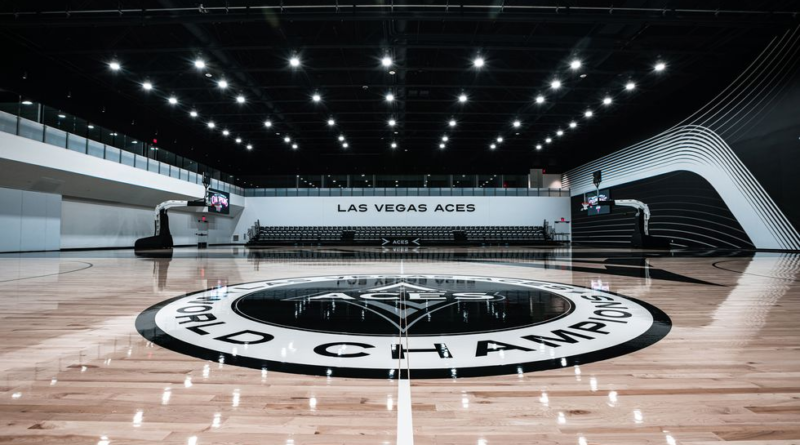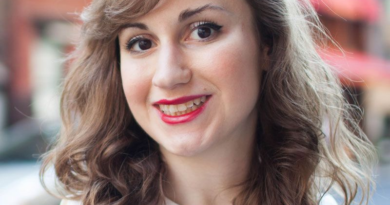Can This Team Reinvent Women’s Sports?
Sometimes, Candace Parker has a hard time believing it’s real. The WNBA star has spent 16 seasons in the league, where she’s been named to seven All-Star teams and has won two championships. Parker has played professionally in Russia, China, and Turkey, and she’s won two gold medals with the U.S. Olympic team, as well as two national championships at the University of Tennessee. At 37, the 6’4” forward is one of the league’s all-time leading scorers, and is considered one of the greatest players in the history of the sport.
So by the time Parker shocked the league by leaving her hometown team, Chicago Sky, to sign with the defending champion Las Vegas Aces in February, it was safe to assume she’d seen it all. What else could possibly be left? But that was before Parker and her teammates had set foot in the Aces’ brand-new practice facility—the first of its kind—and headquarters in Henderson, Nevada, for preseason training last spring.
The 64,000-square-foot building has an interior that looks like a spacecraft that’s touched down from the future. On a visit last May, it still smelled like brand-new carpeting. Since the inaugural season in 1997, no WNBA team had ever had its own dedicated practice facility; Parker, a 16-year veteran, had never even had her own locker. In Chicago, the Sky practiced out of a public recreation center in the suburbs, and she and her teammates had to take their things with them after practice to make way for other gym members, like local dads playing pickup and summer league softball players.
So when Parker walks into the behemoth facility on Raiders Way (the Aces’ owner, Mark Davis, also controls the NFL franchise, headquartered next door) and finds not only her own locker, but also a film room with massage chairs, a state-of-the-art weight room, an infrared sauna, two full-size basketball courts, and a family lounge where her two children can hang out she has to remind herself it’s not going anywhere.
“I was telling my wife the other day, I am on eggshells because I’m just like, ‘This can’t be true,’” Parker says in mid-May, still in awe of her new surroundings. “I’ve never had a locker. I’ve never been able to leave my stuff and it’s there all year. That’s never happened. It’s one of those things where I keep thinking it’s gonna get taken away.”
Twenty-seven years into its existence, the WNBA is enjoying an undeniably ascendant moment. The 2020 season, played in an enclosed Florida campus known as the “Wubble” due to the COVID-19 pandemic, was a political turning point for the league, as its players’ advocacy coincided with protests against police brutality that summer. Since then, quality of play in the league has continued to improve, and viewership has followed. The 2022 season—which ended in the Aces’ first-ever championship—was its most-watched in 16 years. (The college game is on a similar trajectory: Last spring’s women’s final was the most-viewed NCAA basketball game, men’s or women’s, to ever air on ESPN platforms.)
In the offseason, the WNBA’s long-held axes of power continued to shift, in telegenically promising fashion: While Las Vegas signed Parker, the New York Liberty added generational talents Breanna Stewart, Jonquel Jones, and Courtney Vandersloot, ushering in what some are calling the WNBA’s “superteam” era, as well as a shiny new cross-country rivalry with the potential to further boost the league’s ratings.
Las Vegas is leading the way forward for the WNBA in another crucial way. Under Davis, who took over the Raiders from his father, Al, and bought the Aces from MGM in 2021, the team is setting a new bar for long-term franchise investment in women’s sports. The $40 million practice facility is one piece of the puzzle; so, too, is head coach Becky Hammon’s $1 million-plus salary, which has made her the highest-paid coach in league history.
Hammon’s February 2022 signing was considered a coup for both the team and the league. Davis wooed her away from the NBA’s San Antonio Spurs, where she’d been hired as the league’s first full-time woman assistant coach under coaching legend Gregg Popovich in 2014. (It’s widely held that, should she want it, Hammon could eventually become the NBA’s first woman head coach; her name came up repeatedly during the Toronto Raptors’ job search this past spring.) At the time, Las Vegas was coming off a strong season and boasted three recent number one draft picks on the roster in Kelsey Plum, A’ja Wilson, and Jackie Young. Hammon’s salary was effectively a mission statement for Davis, who grew up watching women’s hoops with his father, and believes that the best way to show that the WNBA’s labor is valued is literal—with dollar signs. So far, he’s made his point. The Aces’ 2022 title was Las Vegas’s first in major sports, and this year, season ticket sales have nearly tripled.
But Davis’ compensation hopes remain hamstrung both by the fact that WNBA revenues are well below those of the NBA and by the WNBA’s 2020 collective bargaining agreement (CBA), which ushered in significant salary increases and improved benefits for players, among other things, but also maintained strict limits on travel options and a salary cap. The Aces’ star wing Young, for example, is the league’s highest-salaried player, at $252,450—still just a quarter of Hammon’s salary. For comparison, the highest-paid NBA mascot, the Denver Nuggets’ mountain lion, reportedly earns $625,000 per year. The current CBA will be up for renegotiation in 2027.
The Aces’ aggressive moves haven’t come without controversy. In February, news broke that the league was investigating the Aces for allegedly violating league rules regarding impermissible player benefits in connection with negotiations for an extension of then Aces player Dearica Hamby’s contract. It was reportedly also investigating Hammon for violating league and team “Respect in the Workplace” policies related to alleged “comments made by Hammon to Hamby in connection with Hamby’s recent pregnancy.” In May, the WNBA formally stripped the franchise of its 2025 first-round draft pick and suspended Hammon for two games as punishment. Hammon has denied any wrongdoing and the Aces stood behind her in a team statement (Parker has said she and other players reached out to Hammon to say, “We love you,” and Wilson said, “We’re for Becky.”) In its statement, the Aces expressed “deep disappointment” in the outcome of the investigation and said that it is “committed to supporting” all its players.
In Las Vegas, a city that has always embraced growth and excess, “you can actually see the physical dollars being put behind” the team, Plum says. Jennifer Azzi, the Aces’ chief business development officer and a former pro herself, says that throughout her 13-year career, “there was no situation where I felt the level of respect that I’m sure these players feel, and that I now feel as a front-office person in the organization.” When Azzi played for the Detroit Shock in 1999, the team shared facilities with the NBA’s Pistons, and she remembers feeling like she had to make herself scarce when the men were around. “If they were even close to nearby, [I felt] we couldn’t go in the training room,” she says. As a result, “you always felt like you were less than.”
The nearly rapturous tone in which Aces players and staff talk about the team’s ownership might seem overblown if it weren’t also so plainly understood: For those who’ve been around since the WNBA’s early days in particular, the working conditions they’ve found in Las Vegas had always seemed unattainable, an ideal they hardly dreamed would be available in their professional lifetimes.
Even Parker, a generation removed from Azzi, says she hasn’t had unfettered access to a gym, to get shots up or run drills on her own, since college. “The WNBA is arguing over flights and stuff,” she says with an incredulous laugh referring to the CBA limitations. “But a competitive advantage is having a practice facility, too.”
That’s a daunting consideration for the rest of the league, already saddled with finding ways to take down the defending champions. The Aces are at the start of what amounts to an unprecedented experiment in the relatively short history of women’s professional basketball: What happens when a franchise gives its athletes not just the bare minimum, but all the resources they need to do their jobs—and then some? As a product, how will women’s basketball evolve when its players have the option to thrive instead of merely survive?
Parker, who has had eight knee surgeries and values the facility’s recovery resources over all its other bells and whistles, will only get to play in the early stages of that process. Throughout her career, “I would always go to acupuncture, massage, cryo, and hyperbaric chambers using my own means,” she says. Now all those amenities are a key card swipe away, 24 hours a day.
This season, the Aces have one of the most fearsome starting fives ever assembled in the WNBA. Parker and Wilson, both 6’4”, anchor the post, while the lights-out shooter Plum and creative scorer Young are joined in the backcourt by last year’s finals MVP, Chelsea Gray. (“I take care of winning,” Gray says evenly when asked to characterize her role. Her 2022 playoff performance was historic, and she repeatedly made clutch shots when the Aces needed them most.) Under Hammon, a six-time All Star point guard in her playing days, the players are known for dazzling ball movement and stifling defense at the rim. After adding Parker in the offseason, the Aces are the favorites to repeat as champions this fall.
Though the Aces win games with the methodology and efficiency of a card counter—they had the best record in the WNBA at press time, and were leading the league in both points per game and field goal percentage—their group dynamic is silly and prank-forward. Last season, their antics were compiled in a four-part “blooper reel” on YouTube; in one clip, the team’s beloved joker Sydney Colson empties out an arena hallway with a single, silent fart. They take half-court shorts for a cash prize after every team shootaround, and Plum says there’s a running gag about how Hammon unwittingly sets up “That’s what she said” comments during practices and pep talks. They have a hard-earned, giddy familiarity that only comes with spending untold hours a week together—and perhaps from landing in a workplace that takes care of external stressors before they have to deal with them. “I cannot wait until October gets here and I don’t have to see these women every single day of my life,” Wilson tells me, laughing. “We always say we’re like a club team that’s just really good at what we do.”
Even with the superior conditions in Vegas, the salary cap means the Aces players have to be inventive to make a better living playing the sport they love. As Brittney Griner’s harrowing 10-month detainment in Russia emphasized, many WNBA players still make the bulk of their income playing overseas. (Hammon knows the repercussions of this kind of compromise better than most: In 2008, she became a naturalized Russian citizen as part of signing a reported $2 million, four-year deal with a club in Moscow, and faced intense backlash for the move. At the time, her WNBA salary was about $95,000 a year.) Of this season’s starting five, only Gray and Young played abroad last offseason, both in Turkey. An increased salary cap, and higher salaries across the board, would likely alleviate the need to play abroad or develop a steady array of side hustles. “We wear many, many hats,” says Wilson, who cofounded a candle company. “I have to have multiple streams of income, not only because my salary from the W isn’t where it needs to be, but because that’s how I want to generate wealth.”
Another lane for growth WNBA players have shrewdly capitalized on is fashion. On accounts like @LeagueFits, a sports fashion account with nearly a million followers, WNBA players’ looks are immortalized alongside those of their NBA counterparts. It might sound tangential to their work, but the so-called tunnel walk—or the catwalk strut players make between arriving at the arena and getting to the locker room to change into uniforms—has become an adored and interactive part of the league’s fan experience. Plum, who occasionally works with a stylist, says that when she first got into the league, there weren’t even any cameras in the tunnel. Now she thinks it’s “one of the biggest parts drawing in fans.
“We have these beautiful, tall, gorgeous women who can dress, and [we have all] different body types,” she says. NBA millionaires get more attention for their looks, but the women have lots of different styles—sporty, sexy, comfy, swaggy. “Respectfully, it’s easy to buy a couple thousand dollars of whatever designer and put it on your body,” Plum says. “These women are putting things together on a budget. That to me is impressive.” With tunnel fits, Wilson adds, “you tap into an audience that may not necessarily be paying attention to athletes.”
It’s no mistake that it all comes back to growth, and the idea of what’s best for the league as a collective. The Aces may stand apart this year, in both talent and resources, but players and staff repeatedly stressed that their fortune will mean nothing if the Aces’ working conditions doesn’t get replicated around the league. “As someone who’s been over on the men’s side and knows how this should look and feel, I hope it applies pressure to invest in these women and invest in your product the way that [they] have earned and deserve,” Hammon says. “They’re the best in the business, and they should be treated as such.”
“Do we want to grow the Aces?” says Plum, who serves as first VP in the league’s Players Association. “Yeah. But we also want to grow the game. It’s the overarching product. One of the things I’m most proud of in our league is that we’re united, whether that’s on [Griner] or Black Lives Matter or gun control—we actively meet, talk, collaborate, and then stand on issues. Having a united front is super powerful, and I think that’s one of the things that separate us.”
“I just want every franchise to be taken care of in ways that’s not a step down from college,” says Wilson, who flew private to games in the NCAA, which up until this season was an indulgence not permitted by the WNBA’s current CBA, even if owners are willing to pay for it out of pocket. “The players perform well because they feel good. They look good. It’s all a part of it.”
Already, there are signs of emulation throughout the league. In Brooklyn, Liberty owners Joe and Clara Wu Tsai have built out an exclusive arm of the Barclays Center for the team’s practice and recovery facilities; in March, the Seattle Storm broke ground on the $60 million Center for Basketball Performance, which will be used by the team. It’s all part of the slow progress a player like Parker has seen in her long career, and now finally gets to benefit from.
“If I were to sit here and play in the same league I played in 16 years ago, I wouldn’t have done my job,” she says. Years from now, Parker predicts, “you’re gonna be asking [Wilson] the same question. She’s gonna have it good, but hopefully the league is so far ahead at that point that she’s gonna be like, ‘Dang. I wish I was starting right now.’”
This article appears in the September 2023 issue of ELLE.
Emma Carmichael is a freelance writer living in Brooklyn; her stories have appeared in GQ, Rolling Stone, and The New York Times.











